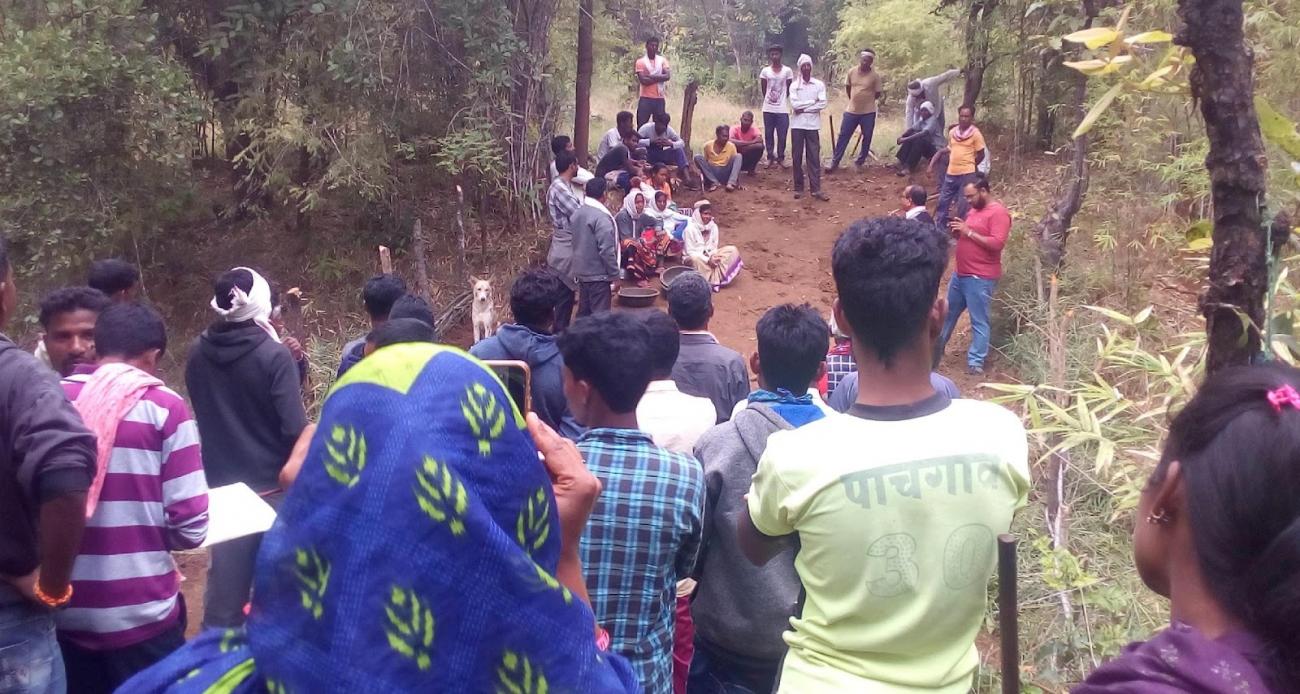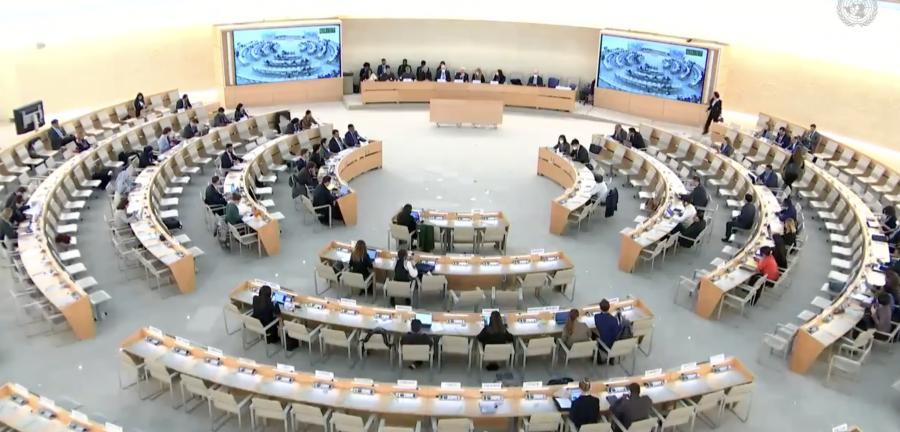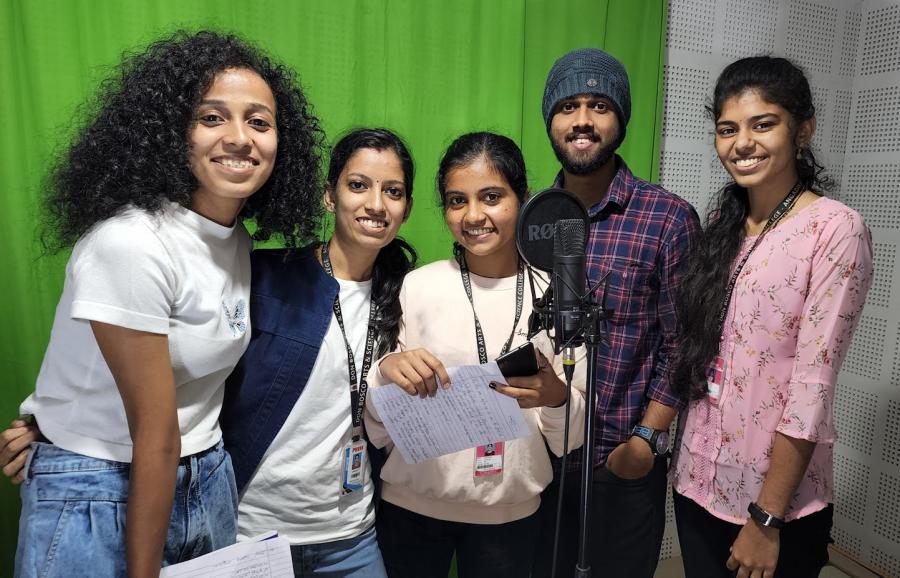
By Santosh Gedam
The village of Pachgaon is nestled in the forests of Central India's Gondpipari block of Chandrapur District. Of Pachgaon’s total population of 224 individuals, around 70 percent are from Indigenous communities identified as Scheduled Tribes in the Indian Census 2011. Chandrapur was earlier known as Chanda. The existence of several forts built by Indigenous kings several centuries ago is a testimony to the fact that Indigenous Peoples habited and ruled them. Amongst those Indigenous kings, the name of Khandkya Ballal Sah is very famous for his leadership and rule of the Indigenous territory. In the Chanda district, a renowned Indian railway junction is named by the name Ballar Sah, though the urban town Ballar Sah has been renamed Ballarpur by the political rulers recently.
Chanda Fort Gate (Source: Wikipedia Commons)
With the passage of time, Indigenous communities were left out of the development process and not much political attention was focused on the perpetual violations of their traditional rights. Therefore, the Indian Parliament enacted the Forest Rights Act (FRA) 2006 to undo historical injustice and recognize several individuals and community rights of forest-dwelling communities, which are overwhelmingly from Indigenous Peoples. However, recognition of forest rights was intensely opposed by the so-called conservationists, and the challenge to the Act is pending in the Indian Supreme Court. In this article, I present the case of Pachgan, which has illustrated how forest-dwelling communities can successfully protect wildlife by creating inviolate zones, conserve biodiversity by maintaining records, and support sustainable and equitable livelihood without any governmental support.
Among hundreds of villages that were guaranteed community forest rights in Central India, the case of Pachgaon is unique on account of several firsts. A sense of ownership of traditional forest and duty towards conservation recognized under the Forest Rights Act motivate the village community (Gram Sabha) in initiating now visible processes and changes on the ground. Several other villages believe in Pachgaon's pathbreaking forest management initiatives and willingly participate in residential workshops at Pachgaon to learn and replicate in their villages. During one such visit I made in November 2020, I had the opportunity to interact with Gram Sabha representatives of Bhamaragad of nearby Gadchiroli District. Forty-odd participants from two Gram Sabhas of Bhamaragad had arrived for a two-day field immersion workshop to learn record-keeping and replicate practices to sustainably manage pristine forests of their villages in Bhamaragad.
Pachgaon Forest with a reserved body of water for wild animals. Photo by Santosh Gedam.
Pachgaon received title to 2,487 acres of forest land in 2012. The story, as told by Sanjay Bhau (Bhau means elder brother in Marathi), a Gram Sabha member, is interesting and inspiring. Before 2012, it was the struggle for their regular livelihood that made them find work in the National Rural Employment Guarantee Act (NREGA). However, they soon realized the physically demanding labour work offered by NREGS could not be continued due to the aging and health issues of villagers. As the awareness about the FRA was spreading in the region due to efforts of non-government organizations working in the livelihood and forest governance domain, Pachgaon Gram Sabha received a suggestion to apply for Community Forest Resource Rights (CFRR) under the FRA. As per Bhau, it took more than two years after claiming for the CFRR to formally receive the CFRR title from the District Level Committee. This period was marked by persistent efforts and some monetary contributions by the villagers with the hand-holding support of the NGO. He shares that in 2012, Pachgaon received only a part of the traditional forest which they had been using for generations. Having received no support from the Forest Department about the mapping of the recognized forest, Pachgaon Gram Sabha used the Global Positioning System (GPS) to accurately map the recognized forest and made soft-copies. The mapping of the forest with prominent places is reproduced as a large printed Google map, which is kept in the Gram Sabha office. The resolutions and micro-plans are discussed in the Gram Sabha and regularly sent to all government offices, including the Chief Minister's Office. Thus, ensuring complete transparency and invitation for coordination with the government departments.
Pachgaon Gram Sabha Office. Photo by Santosh Gedam.
As wisdom says, there is nothing like seeing on the field and learning lessons. With the same spirit as we entered for the guided forest tour of the Pachgaon's forest, we were aptly informed by the guide that the entry of a name and other details of a visitor is mandatory as per Village Rules in the Visitor's register to enter the village forest. As Sanjay Bhau narrates, the registration process ensures that no unauthorized person enters the forest. Bhau explains how a Conservator of Forest (a local forest bureaucrat) once entered their forest without intimation, which led to tension between the forest department and the village. The conflict resulted in the filing of multiple police complaints, and the matter could be somehow settled after the intervention of a local MLA and minister.
Of the total 63 households (Census 2011), every member of the identified age group is mandated to participate in a forest vigilance group to monitor forest activities and share observations on flora and fauna in India’s Observation Register. As we were led by Sanjay Bhau in the forest, we were broadly told about the management plan of the forest. The first thing that Pachgaon did after getting the CFRR title is to develop village-level rules for conservation and sustainable management of the forest. Out of almost 800 rules suggested by 63 households of the villages finally, 115 are accepted and ratified by the Gram Sabha in the democratic process. These rules are the cardinal guiding principles and reasons for the sustainable management of forests over the past eight years. Shalik Bhau, a guide leading during the forest tour, said that all processes originate from the village rules, and their compliance is strictly observed with appropriate sanctioning measures in the rules. Scholars doubt the management of the commons on the ground of over-utilization, but Pachgaon's rules are pathways showing how the commons can be conserved and managed sustainably if appropriate de jure rights are recognized by the government.
Forest Vigilance Board with Group-3 members' names. Photo by Santosh Gedam.
As we entered a dense patch of forest, we were welcomed by a signboard cautioning visitors about the possible habitat of Tiger. We ventured deeper to visit workers paving a Kaccha road for the movement of extracted Bamboo during harvest seasons. Field interaction with workers allowed a deeper understanding of labour deployment for local needs to 40-odd visitors. The interaction was mostly in Marathi, but to facilitate understanding processes, Chinna, a representative of visitors from the Madia Indigenous community, took the lead. Chinna knows Marathi and Madia, an endangered language of a Tribe coming from Bhamaragad. Chinna asked questions in Marathi and explained to his clan people in Madia language. As I understood, Pachgaon gives labor work to any member of Pachgaon Gram Sabha on-demand and pays daily wages. Daily wages are fixed, and unlike NREGS work, which makes labor-based wages. The daily wages model accounts for the physical limitations of a villager demanding manual work. The workers on the field were engaged for days under the supervision of an appointed supervisor. The wage payments are promptly made to the workers in their respective bank accounts. Sanjay Bhau shares that there is no NRGES work in Pachgaon for many years and no receipt of any monetary support from the government. There is an obvious reason for preferring village-level manual work over NREGS’s labour work. He shares that the village is truly Atma-Nirbhar (self-reliant) and pays regular tax on revenue earned for many years.
Forest Interaction with members of Gram Sabhas from Bhamaragad. Photo by Santosh Gedam.
Pachgaon Gram Sabha has set aside around 85 acres of forest exclusively as inviolate zones called Devrai for the habitat of wild animals. They believe that wild animals also need separate and inviolate habitats; thus, the Gram Sabha identified, in the beginning, a suitable patch of inviolate forest. Sanjay Bhau narrates how despite incidences of a number of tiger attacks in Chandrapur district, their village has not witnessed a single case of a tiger attack on a human for many years. In the midst of the forest is a sacred place of all the villagers, Bhivgad. Bhau does not remember when it started but shares that it is much before his great grandfather. The deities of Bhivgad are visited by villagers to pray for rainfall during dry seasons to save crops or to pray for a solution to insect attack on standing crops during farming seasons. There is much folklore about how these processes have helped the village in the past, which sustains their belief in the supernatural power of their deity. As the sun was setting on a wintery evening, Bhau felt it was time to begin the return journey to reach the village boundary before the darkness fell.
Bhivgad as a sacred place. Photo by Santosh Gedam.
As we began returning, Bhau narrates that the Bamboo found in their village is not solid enough in its core so that it can only be used for a specific purpose effectively and not for pulp making by the papermill. He recounts how adherence to village rules has allowed rapid greening of the forest, particularly no incidence of forest fire has resurrected biodiversity than a government-promoted scheme of planting new saplings. His wisdom tells us that maintaining forest greenery by avoiding forest fire cannot be substituted by plating samplings for several reasons.
Unlike previous practices, this year, due to the COVID-19 pandemic, the Pachgaon village used a web-based tendering process of Bamboo harvested from the forest. The new tendering process affected the local cartel of contractors who used to collude to keep bid prices deliberately low, thereby depriving fair income to the villagers. To equally harvest bamboo, the rules have specific instructions. The village rules mandate a specific quota of 50 bamboos per person (for age-group 18-60 years) for males and females to ensure equity in benefiting from the bamboo income. Any bamboo cut more than 50 is confiscated and becomes the property of the Gram Sabha. The rate for each harvested bamboo is fixed by the Gram Sabha, and weekly payments to beneficiaries' bank accounts are promptly made. Recounting his auctioning experience, Sanjay Bhau shares that this year (2020) due to the e-tendering of bamboo, the contractor nexus was broken, leading to the highest price this year for harvested Bamboo as compared to that of the last few years. He recounts his experience of one such physical auctioning of how manipulation of contractors led to the selling of Bamboo at merely 39 lakhs, which was quoted during the auction for 83 lakhs by a contractor. He remarks that the contractors are very shrewd. The adoption of village forest rules and their strict compliance and sanctioning of violation have ensured that now the Gram Sabha is with almost 3.5 crore of surplus in its bank account, which ensures sustainable livelihood and food securities even during the pandemic. Ramesh Tekam Bhau, a member of the Gram Sabha committee, shares how the rules of forest management have protected villagers during the pandemic when farmers elsewhere are suffering. In Pachgaon, recognition of CFRR has shown the case of how self-reliant a village can become insulating even from the volatility of the market economy. Tekam Bhau shares that now the focus is on value addition to harvested Minor Forest Produce (MFP), which they have in tons in their godown. They have purchased 5 acres of land adjacent to the village boundary for ₹ 500,000 for processing and value addition of MFP a few years before. Tekam Bhau shares the Gram Sabha's resolve to diversify sources of livelihood since bamboo-based income might decline in the future due to the cyclical nature of bamboo life. He believes that the village cannot afford to depend fully on bamboo income going forward. His insight and plans are grounded in his village and forest realities, which might be difficult to understand for planners sitting remotely.
Villages in the vicinity of Pachgaon still could not access CFR rights under the FRA due to discouragement by the local elites as shared by Sanjay Bhau. Village-based local elites have the incentive to resist democratic and equity-based benefits distribution under the CFR rights. The immediate outcome of user access and withdrawal rights under the CFRR is a shortage of labour in villages for farm labour. This might increase wages for the labour which local elites don't want. Thus, they discourage attempts by relatively less empowered Indigenous households from even claiming CFR rights under the FRA. It is more likely that the village elites are non-Indigenous people who have settled on Tribal/Indigenous land. This has changed the power dynamics in the Tribal villages. The Indian Constitution, specifically for this reason to secure the interests of Tribal people from more sophisticated people from the plains, empower the Governor of the State with various provisions in the Fifth Schedule. The shifted village power dynamics could be one reason if the landmark legislation FRA remains short of undoing the historical injustice. Thus, policymakers, particularly the Governor, and courts need to act according to the FRA, which mandates local bureaucracy to actively ensure the spreading of awareness and hand-holding support to achieve the objectives of the FRA in letter and spirit.
--Santosh Gedam is a PhD Candidate, Public Systems Group, Indian Institute of Management Ahmedabad.



